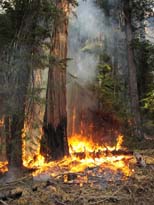- Home
- About S&T
- Taxa/Organisms
- Ecosystems
- Issues
- Methods & Tools
- Reports & Publications
- Location
- Search
Publisher: USGS | Science Center: Forest and Rangeland Ecosystem Science Center (FRESC, Corvallis) | Format: URL
fresc.usgs.gov — Periodic fire is a natural part of sagebrush steppe ecosystems in the Great Basin. However, a suite of human-caused factors has dramatically changed fire regimes in many of these systems. Decades of fire suppression and livestock grazing have produced dense, single-aged sagebrush stands and invasion by cheatgrass (Bromus tectorum) has increased More...

Publisher: USGS | Science Center: Western Ecological Research Center (WERC, Sacramento) | Format: URL
www.werc.usgs.gov — The Fire and Fire Surrogate study is a network of 13 long-term sites established nationwide to evaluate the ecosystem impacts of different fire hazard reduction treatment in forests that historically experienced short-interval, low- to moderate-severity fire regimes. The fuel reduction treatments being investigated by USGS researchers at Sequoia More...

Publisher: USGS | Science Center: Western Ecological Research Center (WERC, Sacramento) | Format: URL
www.werc.usgs.gov — This web resource addresses the positive relationship between cheatgrass (Bromus tectorum) and fire frequency as a major concern for land managers in semi-arid shrublands throughout western North America, particularly in Great Basin sagebrush steppe. Management tools are needed to break this cycle, and in this project we will evaluate the use of More...

Publisher: USGS | Science Center: Western Ecological Research Center (WERC, Sacramento) | Format: URL
www.werc.usgs.gov — Native amphibian and reptile populations worldwide are under threat from exotic invasive species of plants and animals, including other reptiles and amphibians. As habitats are changed and plant community organization is modified by exotic species, delicate relationships between plants and animals are altered or eliminated, creating a negative More...

Publisher: USGS | Science Center: Western Ecological Research Center (WERC, Sacramento) | Format: URL
www.werc.usgs.gov — This project investigates the role of pre-fire fuel reduction manipulation projects on the invasion of nonnative plants. This study is designed to answer the following questions: 1. Do nonnative plants become established within fuel breaks? 2. Are some types of fuel breaks less likely to support nonnative species? 3. Do fuel breaks promote the More...

Publisher: USGS | Science Center: Western Ecological Research Center (WERC, Sacramento) | Format: URL
www.werc.usgs.gov — This web resources discusses the awareness of modern ecologists of the problems caused by the invasion of exotic species into natural areas and the associated negative effects on global patterns of native biodiversity. Once established, some exotic species have the ability to displace or replace native plant and animal species, disrupt nutrient More...

Publisher: Other (Joint Fire Science Program) | Format: .PDF
jfsp.nifc.gov — "Prescribed fire" has been used to reduce hazardous fuel loads, restore historical disturbance regimes, improve forage and habitat for game and livestock species, and promote biodiversity. In some cases, fire has also been used to manage invasive plant species. The goal of this report is to capture the current state of knowledge on the use of More...

Publisher: USGS | Science Center: Western Ecological Research Center (WERC, Sacramento) | Format: URL
www.werc.usgs.gov — This issue overview describes Perennial pepperweed (Lepidium latifolium L.), also known as tall whitetop, as an invasive weed that is found throughout California and in all of the western United States and its effects on wildlife refuges. Native to portions of Europe and southwestern Asia, pepperweed was accidentally introduced into the United More...

Publisher: Invasive Species Information Node | Format: URL
invasivespecies.nbii.gov — This research project website stresses the importance of developing early detection methods to prevent the spread of non-native species. Land managers currently control the spread of invasive non-native plant species after they have already become established instead of trying to prevent the establishment of the species. Lists of probable invasive More...
Publisher: USGS | Science Center: Upper Midwest Environmental Sciences Center (UMESC, LaCrosse) | Format: URL
www.umesc.usgs.gov — This web resource provides decision makers with the information needed to maintain the Upper Mississippi River System as a viable multiple-use large river ecosystem. This resource also includes Data and sampling information, publication links, reports, other related documents and statistics, as well as links to field stations and other projects More...

Publisher: USGS | Science Center: Western Ecological Research Center (WERC, Sacramento) | Format: URL
www.werc.usgs.gov — Invasion and subsequent restructuring of ecosystems by nonnative organisms is taking on increasingly urgent significance as an example of human-caused environmental change with potentially dramatic consequences. This web resource discusses the affects of vascular plants - particularly in Sequoia, Kings Canyon, and Yosemite National Parks - on the More...

Publisher: USGS | Science Center: Western Ecological Research Center (WERC, Sacramento) | Format: URL
www.werc.usgs.gov — Pinon-juniper woodlands have expanded beyond their historical range in the western United States, due partly to land management practices such as fire suppression that began with settlements of the region in the late 1880s. This woodland expansion has replaced sagebrush steppe vegetation, leading to decreased wildlife habitat, soil seedbanks, and More...
